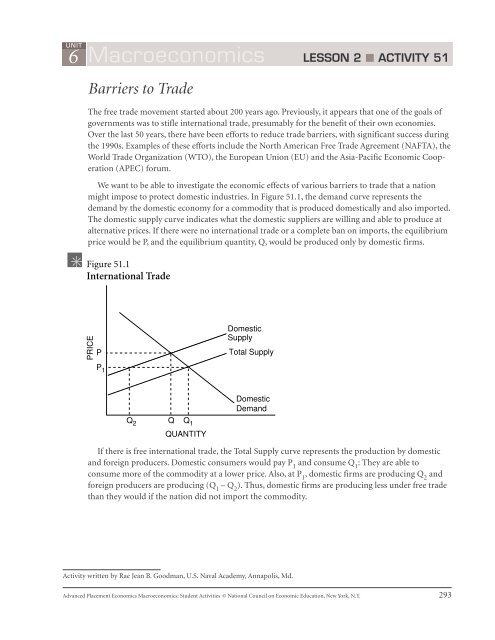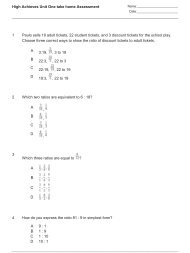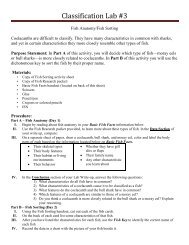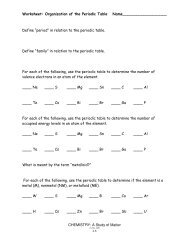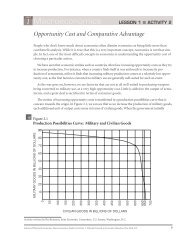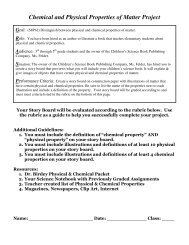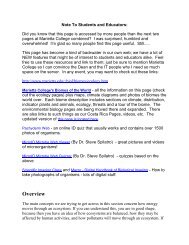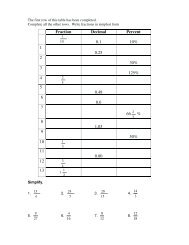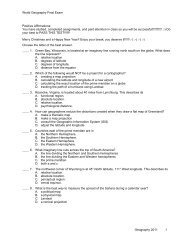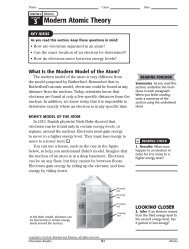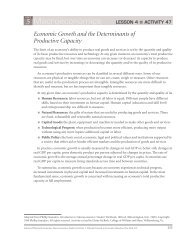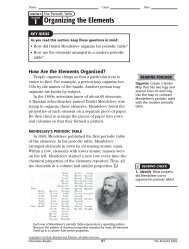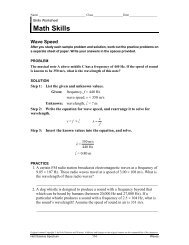Unit 6 Lesson 2 - Activity 51
Unit 6 Lesson 2 - Activity 51
Unit 6 Lesson 2 - Activity 51
You also want an ePaper? Increase the reach of your titles
YUMPU automatically turns print PDFs into web optimized ePapers that Google loves.
6UNITMacroeconomics LESSON 2 ■ ACTIVITY <strong>51</strong>Barriers to TradeThe free trade movement started about 200 years ago. Previously, it appears that one of the goals ofgovernments was to stifle international trade, presumably for the benefit of their own economies.Over the last 50 years, there have been efforts to reduce trade barriers, with significant success duringthe 1990s. Examples of these efforts include the North American Free Trade Agreement (NAFTA), theWorld Trade Organization (WTO), the European Union (EU) and the Asia-Pacific Economic Cooperation(APEC) forum.We want to be able to investigate the economic effects of various barriers to trade that a nationmight impose to protect domestic industries. In Figure <strong>51</strong>.1, the demand curve represents thedemand by the domestic economy for a commodity that is produced domestically and also imported.The domestic supply curve indicates what the domestic suppliers are willing and able to produce atalternative prices. If there were no international trade or a complete ban on imports, the equilibriumprice would be P, and the equilibrium quantity, Q, would be produced only by domestic firms.Figure <strong>51</strong>.1International TradePRICEPP 1DomesticSupplyTotal SupplyQ 2Q Q 1QUANTITYDomesticDemandIf there is free international trade, the Total Supply curve represents the production by domesticand foreign producers. Domestic consumers would pay P 1and consume Q 1: They are able toconsume more of the commodity at a lower price. Also, at P 1, domestic firms are producing Q 2andforeign producers are producing (Q 1– Q 2). Thus, domestic firms are producing less under free tradethan they would if the nation did not import the commodity.<strong>Activity</strong> written by Rae Jean B. Goodman, U.S. Naval Academy, Annapolis, Md.Advanced Placement Economics Macroeconomics: Student Activities © National Council on Economic Education, New York, N.Y. 293
6UNITMacroeconomicsLESSON 2 ■ ACTIVITY <strong>51</strong> (continued)Part AQuotasInstead of permitting free trade or imposing a complete ban, a nation may decide to set a quota tolimit the number of imports. Import quotas are sometimes referred to as voluntary export restraints(VERs) because the two countries have agreed that the exporting nation will not export more than acertain amount.We can see the effect of an import quota by looking at Figure <strong>51</strong>.2. Here the domestic price wouldbe P and the quantity would be Q if there were a complete import ban. If there were free trade, theprice would be P 1and the quantity demanded by domestic consumers would be Q 1.Notice that under free trade, the entire market is supplied by foreign producers as the market isdrawn in Figure <strong>51</strong>.2. This does not have to be the case; it depends on the costs of the domesticindustry and the domestic industry’s ability to sell at the lower price.Suppose the importing nation imposes a quota, or VER, of X amount; the Total Supply with Quotacurve represents the new supply curve. Total Supply with Quota is the domestic supply curve plus Xamount at every price level (X = Q 2– Q 3). The domestic price has risen from P 1to P 2, and consumersare able to purchase less of the commodity. Equilibrium quantity has decreased from Q 1units to Q 2units. However, domestic producers are now producing Q 3units, and foreign producers are supplyingX = Q 2– Q 3.Figure <strong>51</strong>.2Effects of Import QuotaPRICEPP 2P 1DomesticSupplyTotal Supplywith QuotaTotal SupplyDomesticDemandQ 3Q Q 2 Q 1QUANTITY294 Advanced Placement Economics Macroeconomics: Student Activities © National Council on Economic Education, New York, N.Y.
6UNITMacroeconomicsLESSON 2 ■ ACTIVITY <strong>51</strong> (continued)1. Use Figure <strong>51</strong>.3 to demonstrate what will happen to the domestic price, domestic production andthe amount of imports if a quota is removed. The Domestic Supply and Total Supply curves onthe graph are without any barriers to trade imposed. Be sure to show on the graph the supplycurve with the quota. It is not on the graph now.Figure <strong>51</strong>.3Eliminating a QuotaDomesticSupplyPRICEPP 1Total SupplyDomesticDemandQQUANTITYQ 1Advanced Placement Economics Macroeconomics: Student Activities © National Council on Economic Education, New York, N.Y. 295
6UNITMacroeconomicsLESSON 2 ■ ACTIVITY <strong>51</strong> (continued)2. Write a paragraph summarizing the advantages and disadvantages of a quota to the domesticeconomy. Be sure to discuss the impact on domestic consumers, domestic producers and foreignproducers.3. If a quota is imposed, explain the methods people would use to circumvent the effects of thequota.296 Advanced Placement Economics Macroeconomics: Student Activities © National Council on Economic Education, New York, N.Y.
6UNITMacroeconomicsLESSON 2 ■ ACTIVITY <strong>51</strong> (continued)Part BTariffsA tariff is a tax on an import. The imposition of a tax increases the cost of each unit, which is representedby a decrease in supply. This would result in an increase in equilibrium price and a decrease inequilibrium quantity.4. Modify Figure <strong>51</strong>.4 to show the effect of an import tariff of $T per unit. Be sure to show on the graphthe amount of the tariff. Add one curve to the graph, and label it Total Supply with Tariff. After theimposition of the tariff, label the new equilibrium price P Tand the equilibrium quantity Q T.Figure <strong>51</strong>.4Effect of Import TariffDomesticSupplyPRICEPP 1Total SupplyDomesticDemandQQUANTITYQ 15. What is the effect of the tariff on the equilibrium price and quantity for domestic consumers comparedwith the free trade levels?6. What are the similarities between the effects of a quota and those of a tariff?Advanced Placement Economics Macroeconomics: Student Activities © National Council on Economic Education, New York, N.Y. 297
6UNITMacroeconomicsLESSON 2 ■ ACTIVITY <strong>51</strong> (continued)7. What is the primary difference between the effects of a quota and those of a tariff?8. Suppose a country can impose either a quota that raises the domestic price to P 2as in Figure <strong>51</strong>.2or a tariff that raises the domestic price to P 2. Explain whether domestic consumers would prefer atariff or a quota and why.Part CExport SubsidiesNations may choose to assist domestic industries by providing subsidies to an industry. The subsidieswould lower the costs and permit the industry to sell at a lower price. This assistance is called anexport subsidy because the industry can now compete on the world market and export some of itsproduct to other nations.9. Modify Figure <strong>51</strong>.5 to show the effects of an export subsidy on domestic producers. Indicate as P Sand Q Sthe equilibrium price and quantity for domestic consumers after an export subsidy. Add twocurves to the graph: a Domestic Supply with Subsidy curve and a Total Supply with Subsidy curve.Figure <strong>51</strong>.5Effects of a SubsidyDomestic Supply without SubsidyPRICEPP 1Total Supply without SubsidyDomestic DemandQQ 1QUANTITY298 Advanced Placement Economics Macroeconomics: Student Activities © National Council on Economic Education, New York, N.Y.
6UNITMacroeconomicsLESSON 2 ■ ACTIVITY <strong>51</strong> (continued)According to Figure <strong>51</strong>.5 with your modification, what would be the equilibrium price and quantityfor(A) a completely closed economy (no imports and no subsidy)? __________________(B) an open economy (completely free trade) with no export subsidy? __________________(C) an open economy with a domestic export subsidy? __________________10. What is the effect of an export subsidy on the equilibrium price and quantity for domestic consumersrelative to the free trade equilibrium without a subsidy?11. If an industry receives a subsidy, what will happen at the equilibrium to domestic productionand the amount of imports?Advanced Placement Economics Macroeconomics: Student Activities © National Council on Economic Education, New York, N.Y. 299
6UNITMacroeconomicsLESSON 2 ■ ACTIVITY <strong>51</strong> (continued)Part DApplications12. One of the goals of the European Union is the elimination of trade barriers among the membernations. If this goal is achieved, which groups of people will benefit and which will not benefit?13. Identify the arguments frequently used to impose some type of trade barrier. Discuss the prosand cons of three arguments.300 Advanced Placement Economics Macroeconomics: Student Activities © National Council on Economic Education, New York, N.Y.


